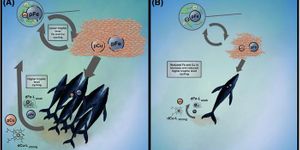A recent study by researchers at Virginia Tech looked at the giant salamanders known as “hellbenders.” Scientists wanted to understand why hellbender population has been in decline in recent decades.
Led by professor William Hopkins, a research team discovered that rates of hellbender filial cannibalism are correlated with levels of deforestation in their habitat. In other words, hellbender fathers living in deforested areas are “far more likely” to eat their young if they’re living in places with less forest cover.
Using underwater artificial nesting shelters of concrete boxes, the researchers followed 182 nests at 10 sites over the course of 8 years. Through the course of eight years, they conducted field work in icy streams, wearing wetsuits and snorkels to observe hundreds of shelters underwater.
Their findings showed that low forest cover correlated with nest failure rates, with failure rates of 100% at several nest sites, largely due to cannibalism of the clutches (group of eggs) by the father. They controlled for poor health in fathers and small clutch size, finding in fact that larger clutches were most vulnerable, especially those at degraded sites with lower cover. The study suggests that this phenomenon may be a result of differences in water chemistry or siltation resulting from deforestation, which in turn affect father physiology or reduce the youngs’ viability.
The most important finding from the study is identifying a possible cause of chronic hellbender population declines. "This is an animal that has been resilient over millions and millions of years, and something that we're doing to the planet is severe enough that it's causing them to disappear, and disappear quickly," Hopkins said. "I feel like we have an obligation to solve this problem."
Though they were once the apex predators of many freshwater streams, today the hellbender is listed as vulnerable on the IUCN Red List of Threatened Species. They typically serve important roles in ecosystems, influencing interspecies dynamics through their predation as well as by merely occupying a significant portion of the biomass in a given area.
Years of braving cold water and donning snorkels have yielded additional findings, as well. "We've discovered two parasites new to science that nobody knew existed, one is a leech that we think specializes on hellbenders, and the other is a microscopic blood parasite, a trypanosome. We've also been able to describe the hellbenders' hormone cycles,” Hopkins explained.
For now, the problem of filial cannibalism among hellbenders can first be addressed by taking steps to improve forest cover around streams, especially in areas affected by deforestation. "The benefits of doing so are far reaching -- what is good for hellbenders is also good for other aquatic animals like mussels and fish, many of which are also declining,” Hopkins said. “Reforesting stream corridors is also good for terrestrial wildlife like migratory birds. And of course, better water quality is good for us,.”
Sources: The American Naturalist; ScienceDaily; IUCN; Journal of Herpetology



